
在2020年众多让美国人夜不能寐的危机当中,新冠疫情引发的经济“K形复苏”理论显得格外引人注目。
在这个得到越来越多证据佐证的假设中,一年的封锁、隔离和不确定性让美国居家办公的管理层与靠薪资度日的一线员工之间的贫富差距越拉越大,而且这两个组别之间的财富状况就像K的上下两笔一样,处于背道而驰的状态。
与此同时,股市亦经历了其自身的K形复苏,只不过其结果并不尽如人意。
由于今年诸多事件的发生,让我们比以往更加依赖于科技,例如从电子商务到电话会议, FAAMG(Facebook、苹果、亚马逊、微软和谷歌)五大科技巨头股票年初至今的回报率达到了52.5%,而标普500其他495只股票的回报率仅有6.3%。这五家公司的总市值目前达到了7.2万亿美元。
如果你将所有的资产组合都放到了一个典型的“市值加权型”标普500交易所交易基金中,你资产的23%都将用于购买这五家公司的股票。
在感恩节到来前的数周里,有两款新冠疫苗传来了好消息,后续可能还会涌现出更多的疫苗。
尽管面临着非常困难的寒冬,但很有可能这些救命股票将有助于全球经济在2021年摆脱疫情影响,扭转局面。而且如果幸运的话,它还将终结上述的两种K型复苏,实现足够强劲且范围更加广泛的复苏。
就股票而言,这一线希望也让专业人士开始重新思考从哪里下手才能获得最大回报。
在受疫情冲击最严重的行业中,有人认为,随着公司营收的恢复,其股价应该有更多的上行空间。Causeway Capital首席执行官萨拉•凯特拉说,在经济回归常态之后,“一飞冲天的将是原材料、消费必需品、金融和工业股。”
很多经理认为那些在疫情爆发后下跌速度超过美股的非美国股票,也有望大幅上涨。Nuveen全球股票负责人萨伊拉•马利克称,不管出现什么情况,未来并非是FAAMG一枝独秀的局面,“我并不认为我们在2021年末会说,‘这五家增长型股票才是你应该拥有的一切。’”
在这些领域下注并不意味着就得放弃科技股。科技在推动经济增长方面的核心作用是不容否认的。
尽管如此,分析师预计,科技公司在2021年的盈利增速要低于标普500整体的盈利增速。另一个迹象表明,随着全球经济回归健康,其他行业的股票亦有可能迎来一个加长版的牛市。
有鉴于此,我们挑选了六个门类的股票,它们有望在全球重建之际提供丰厚的回报。
能源与基础设施
随着美国组建新的经济支柱,这类股票将受益。
美国的新一届政府管理者通常会给投资者一个加大基础设施投资力度的希望,而且这类预算有望得到两党的同时支持。
总统继任者乔•拜登在竞选时祭出了两个尤为及时的基础设施主题:一个是呼吁对“可持续发展基础设施”进行2万亿美元投资的气候计划,以及一个投资农村宽带建设的200亿美元提案。
然而,即便这笔资金未能在陷入僵局的国会获得通过,但我们仍有理由去押注那些打造上述未来经济支柱的企业。
很多投资者都将目光投向了可再生的电力资源。
尽管风能和太阳能仅占当今全球发电量的约7%,国际能源机构预计这个数字到2040年将升至40%。帮助管理安本标准全球基础设施收益基金(Aberdeen Standard Global Infrastructure Income Fund)的资深资产组合经理乔什•杜伊茨说:“可再生能源领域将迎来长达数十年的增长机遇,我们当前处于最初期的阶段。”他是公用事业公司的粉丝,它们因其高派息额而被称之为“收益公司”,其中包括英国的Atlantica Sustainable Infrastructure(派息额5%)以及在美国和海外经营太阳能电板安装以及风力涡轮机的Clearway Energy(派息额4.6%)。
杜伊茨还十分钟爱美国最大的可再生能源设施公司 NextEra Energy。该公司计划于明年在电池存储的新前沿领域投资10亿美元。这项创新是可再生能源成为主流的关键,因为它能够让人们在太阳落山或无风情况下继续使用能源。
五大巨头的印迹……
Facebook、苹果、亚马逊、微软和谷歌(所谓的FAAMG)如今占到了标普500近四分之一的市值。
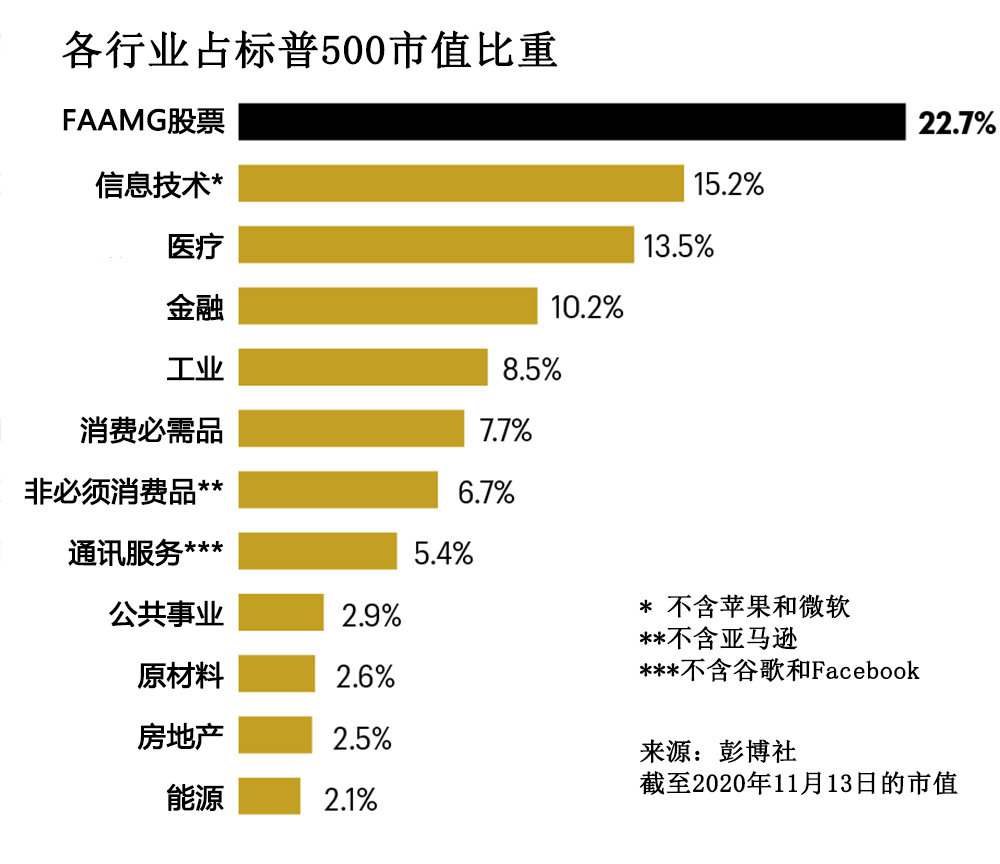
在疫情之前,美国移动数据消费的年增幅已经超过了30%。由于工作和教育均开始依赖于电话会议这种形式,因此我们在未来将迎来更多的数据消费。这意味着电信公司有必要在未来继续完善其5G网络,其中一个办法就是在信号塔上安置更多的天线。
ClearBridge Investments资深资产组合经理尼克•朗格里解释说:“其背后的原理在于,要求的带宽越高,离信号塔的距离就得越近。”这一点对于像Crown Castle和American Tower这样的房地产投资信托来说是个好消息。朗格里预测这类企业的营收将呈现出长达十年的高值个位数增长。
杜伊茨推荐了西班牙的Cellnex,随着越来越多的欧洲移动通讯公司将其信号塔业务交给专业运营商,这家公司亦通过收购不断发展壮大。
推荐股票
Atlantica Sustainable Infrastructure (AY)
Clearway Energy (CWEN)
NextEra Energy (NEE)
Crown Castle (CCI)
American Tower (AMT)
Cellnex (CLNX)
医疗股
有待于新冠疫情减少对医疗系统的依赖。
新冠疫情是一场医疗危机,对一些医疗公司造成了严重的冲击。
作为设备制造商和医院的一个重要盈利点,择期手术需求出现了放缓或骤停,而上了岁数的人尤其会推迟各类医疗服务,以避免感染新冠病毒。但尽管新冠疫情相关的挑战依然存在,最近积极的疫苗进展也促使一些投资者加倍押注那些能够在回归常态后受益的公司。
詹森投资管理公司(Jensen Investment Management)董事总经理兼资产组合经理艾瑞克•斯科恩斯腾推荐Stryker,这是一家整形外科移植物、人工关节以及老龄人口所需其他科技产品的顶级制造商。
Stryker拥有斯科恩斯腾所称的“先驱优势”,也就是其用于髋关节和膝关节置换的机器人辅助手术平台。Stryker几乎半数的业务都可被划分为“择期手术”业务,但由于这些手术不断涌现,分析师预测,该公司2021年营收增幅将超过13%。其股票当前的估值略低于行业平均水平。
在兴旺之年发展壮大
随着疫情使人们加深了对数字工作、电商和家庭娱乐的依赖度,FAAMG的股价一飞冲天。
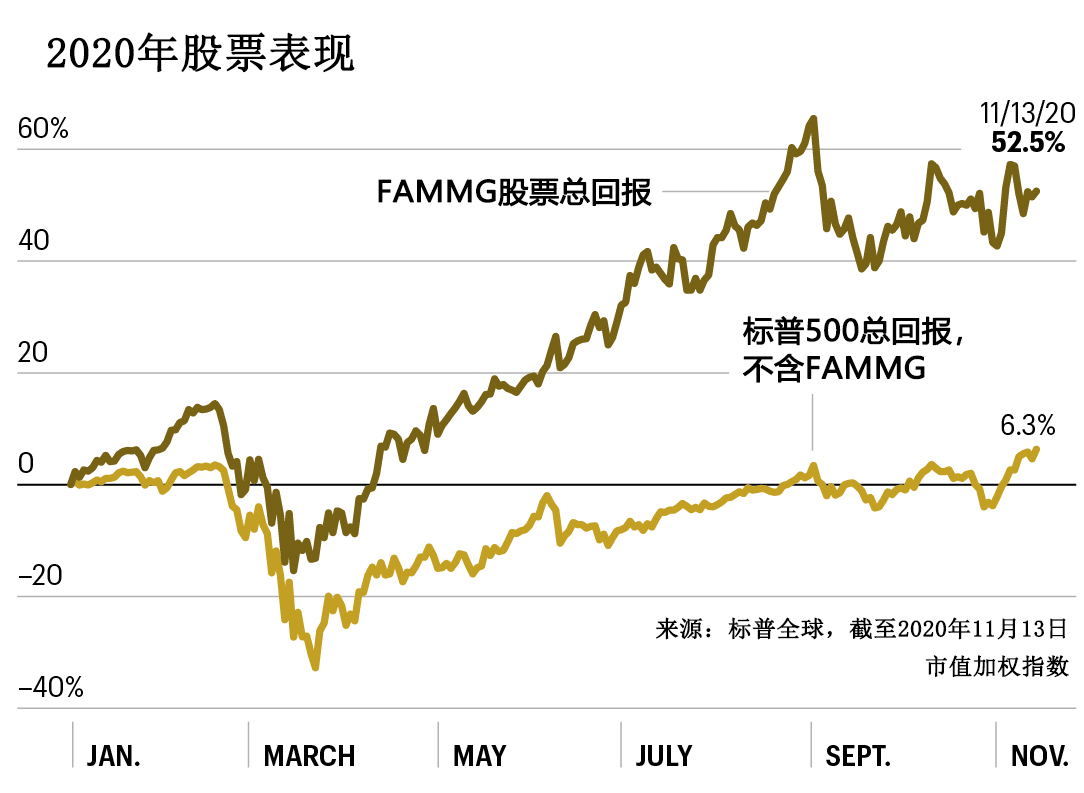
择期手术的全面回归还将使Teleflex受益,其产品包括众多在血管、尿路手术以及膀胱疾病治疗过程中使用的器具。
管理Parnassus Mid Cap Fund基金的罗瑞•凯斯认为,正在迈入老年阶段的婴儿潮一代对Teleflex设备有着长远需求。公司股票并不便宜,其远期市盈率接近30倍,但分析师认为Teleflex 2021年的营收增幅将达到13.5%。
险企巨头联合健康集团顺利地挺过了疫情的冲击。
在疫情初期,其利润因择期手术的下降甚至有所上升,使得公司能够向客户提供一些返利。然而,Nuveen的塞拉•马利克将选举后风险的缺失称之为险企“最大的利好因素”:有鉴于下一届国会有望出现势均力敌的显著分歧,“全民医保”计划很难实现。
马利克预计联合健康将以最快的速度在5年内扩大其在“医保优势计划”领域的印记,其Optum业务也将揽获更多的会员(其中包括医保储蓄账户和支付处理)。公司股票的远期市盈率为22倍,与标普500的平均水平相当,而且马利克认为,随着联合健康的业务模式回归常态,以及其股价的攀升,公司可能会消除这一鸿沟。
推荐股票
Stryker (SYK)
Teleflex (TFX)
联合健康集团(UNH)
消费股
封锁过后,一些零售商和直播节目将东山再起。
疫情迫使全国店面关闭之后,零售向电商转变的漫长过程得以加速推进。然而,如果疫苗到来驱使更多的人回到实体店,那些主营实体店的公司可能会为投资者带来不俗的回报。对于折扣零售商来说更是如此,因为他们一直能够用“寻宝”体验以及在动荡经济中备受欢迎的低价策略来取悦客户。
Parnassus的凯斯便是Burlington Stores的一名粉丝,这是美国仅次于Ross Stores和TJX的第三大折扣零售商。Burlington众多店面位于独立的大楼而不是大型商场中,比实体店零售商受疫情冲击要小,因此可以较早重新开业。新首席执行官迈克·欧·萨利文于2019年从Ross来到了公司,正在投资用于供应链管理的科技,以及有助于Burlington继续改善其运营利润率的分析工具。
在当前这个时代,人们更喜欢外出而不是待在家中,这可能对于服饰巨头VF来说是一个好消息,该公司旗下资产组合公司包括户外品牌Vans,北脸和添柏岚。
凯斯称,投资电商获得了回报,公司销售额在最近几个季度有所增长,而且公司在近些年剥离了像诺帝卡和Reef这样的老品牌以精简其产品线。VF最近以21亿美元收购备受青少年追捧的大热街头服饰品牌Supreme,凯斯认为该品牌有望成为公司增长的一个潜在加速引擎。
弥补错过的时间
分析师预计,随着经济恢复快速增长,2021年几乎各行各业普遍都会出现利润的大幅增长。
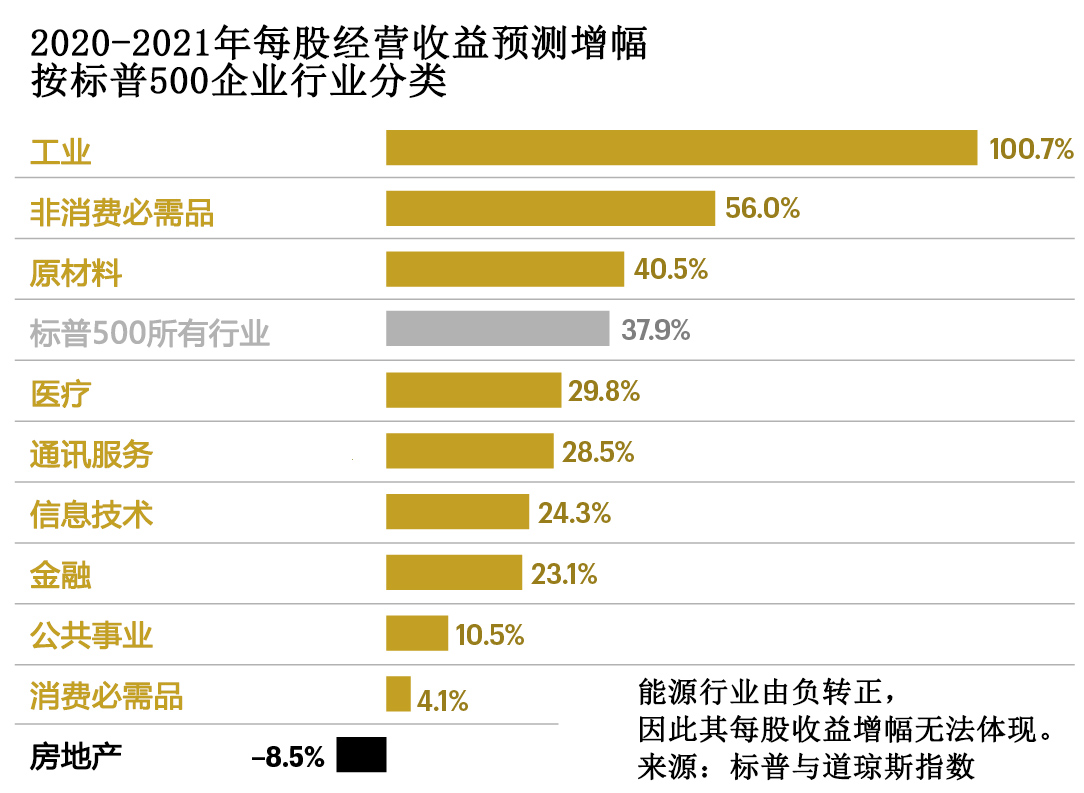
高盛资产管理选股业务联席负责人凯蒂·科克认为,在更加年轻的消费群体中,像音乐会和旅游这类体验要比零售更为重要,而且一旦疫苗出现之后,专业从事此类体验的企业可能会因为猛增的需求而蓬勃发展。
这对于Live Nation来说可谓是天大的好消息,该公司是音乐会和相关活动的巨头企业,旗下子公司包括Ticketmaster等。Live Nation的营收在过去12个月中下滑了近60%,而且由于现场活动不知何时才能全面恢复,华尔街预计公司的营收在2021年依然会在低位徘徊。然而科克指出,公司所拥有的“资产负债实力能够让公司度过继续拖延的经济关停。”对于因疫情而关闭的活动中,超过80%的Live Nation的客户选择持有其门票,而不是退款。对于科克来说,“这个有力的数据点证明,人们对这类活动异常喜爱。”
推荐股票
Burlington Stores (BURL)
VF Corp. (VFC)
Live Nation (LYV)
银行股
疫情赶走了投资者,但 “四大”中的很多银行依然斩获了稳定的利润。
就经济健康度的形象代言人而言,没有哪一组企业能够比四大金融巨头——摩根大通、美国银行、富国银行和花旗集团——更适合这一角色。到目前为止,市场回归基本上都与四大无缘。自1月1日以来,尽管标普增长了10%,但四大平均下跌了22%。然而,这一现象也让其股票变得异常便宜,一旦其利润反弹,投资者可能会收获巨大的回报。
这里存在多个对银行有利的因素。不断改善的经济将逐渐抬升利率,推高“净利息收益”,也就是银行家庭和信用贷款利息与存款利息之差。四大在接管受疫情冲击的贷款之后依然公布了稳定的营收。这一点部分归功于一项新会计准则的实施,从1月到4月,四大共计为不良信贷认列了620亿美元的拨备,覆盖了其预计的新冠疫情引发的所有损失。
专业研究公司Portales Partners负责人查尔斯·皮博迪称,好消息在于:“除非美国再次经历深度萧条,亏损应该维持在一个大幅降低的水平。”
资金不足
银行股已经落后于大盘,但随着经济向常态迈进,银行收益将出现大幅跃升。
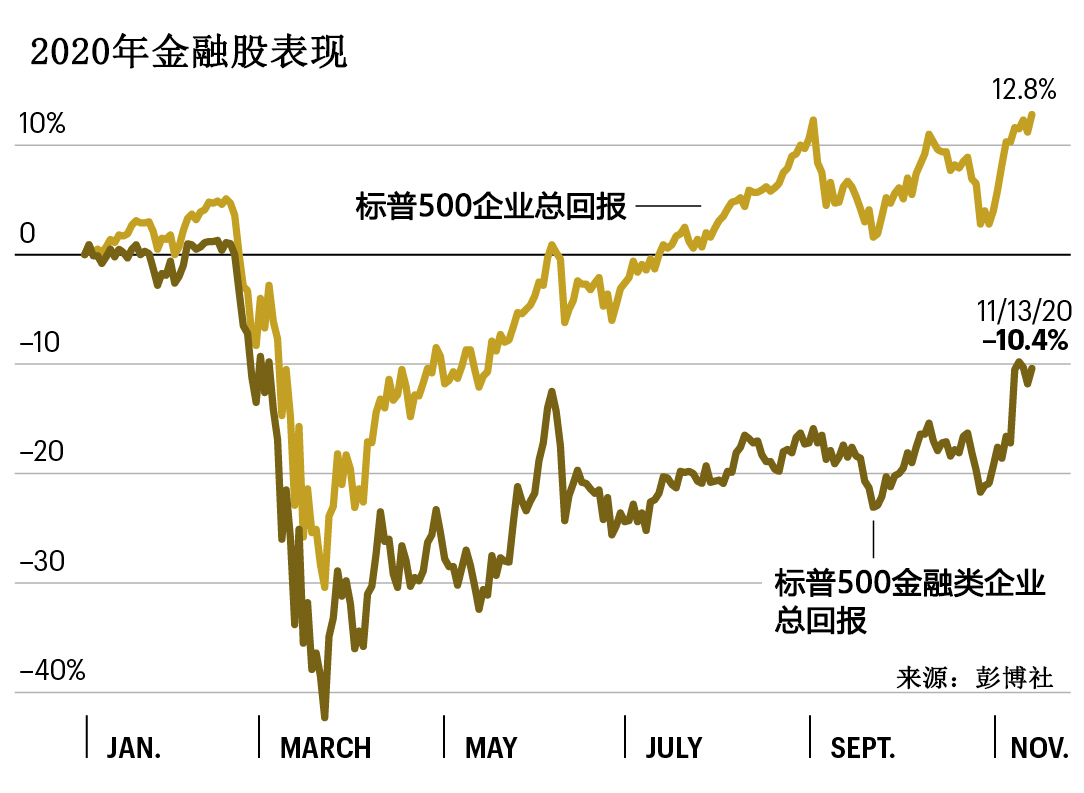
美国银行从上行经济中获益的可能性尤为突出,因为公司更多地专注于消费者而不是投行或贸易。
在第三季度,不断下滑的利率让美国银行的净利息收益减少了21亿美元,降幅达到了17%,但该银行依然报出了49亿美元的利润。该行认为,10年期国债收益率每上涨一个百分点,其税前收益就会增长33.4亿美元。
皮博迪认为,美国银行侧重消费者的业务组合将成为经济恢复的超级受益者。他说,受信用卡和抵押贷款需求的刺激,“此次反弹更多的是在于消费而不是华尔街金融业”。美国银行相对于2019年利润的市盈率仅有8,其股价比摩根大通还便宜。
富国银行倒是有一定的风险。银行一直受累于与监管方打击其不道德销售行为有关的成本,而且美联储已经对其业务增长实施了严格的限令。富国银行的股价从其2018年的峰值水平下跌了60%。
然而,首席执行官查尔斯•斯卡夫在削减成本上一直颇有建树。与美国银行一样,富国银行主营消费业务,去年发放的抵押贷款数额在四大中居于首位。有鉴于于此,它有望成为利率上升期间的大赢家。
推荐股票
美国银行 (BAC)
富国银行 (WFC)
航空与航天
忧心忡忡的乘客与限飞令也无法阻止其股价的上涨。
11月振奋人心的疫苗数据让航空公司股价从低点一飞冲天,然而投资者担心其股价在近期内难以企及新高。尽管注射了疫苗的商务差旅人士会更放心地搭乘航班,但只要能够通过Zoom沟通,他们依然不大愿意乘飞机参加工作会议。同时,飞机在没有满客的情况下执飞也没有利润可言。
那些希望从航空旅行恢复中大赚一笔的投资者,转而进一步将目光投向了供应链,也就是那些制造和维修飞机零部件的公司。
Schroders的投资策略师比尔•卡拉汉说:“航空公司省钱的方式有很多种,但它们无法在飞机维修方面省钱。”只要飞机起飞之后,零部件就会出现磨损,维修要比购买全新的飞机便宜的多,而且航空公司现在也没钱购买新飞机。
卡拉汉在谈到像克利夫兰TransDigm以及康涅狄格州斯坦福德的Hexcel这类制造商时说,“他们对波音的痛苦可谓是感同身受。”TransDigm生产从驾驶舱到厕所等各类飞机部件,而Hexcel则专业生产飞机碳纤维。尽管这两家公司股价最近均出现了飙升,但依然远低于其疫情前的水平。Hexcel的股价较其2019年的峰值下跌了近40%。
持有规律
随着疫情病例的再次激增,美国航空旅行在经历了夏秋两季的部分恢复之后趋于平稳。
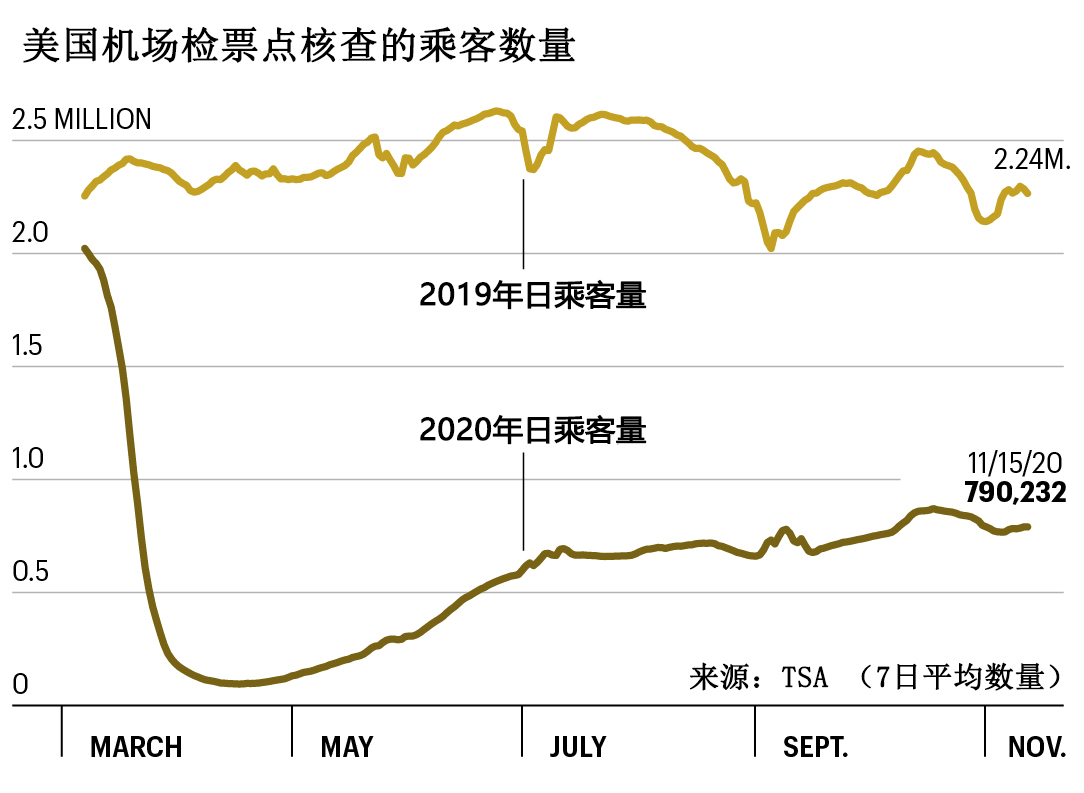
卡拉汉建议,对于那些愿意尽早押注航空公司股票的投资者来说,不妨考虑那些专注于美国市场的企业:“国际差旅受到影响的期限将长于本土差旅”。相对于其他美国大型航空公司,专注于美国本土的西南航空在疫情期间较为顺利地通过了考验,而且利用了疫情导致的差旅萧条,于2021年中期之前在其航线中新增了10个机场。
Commonwealth Financial Network资产组合管理负责人皮特•埃塞尔认为,从长远来看,捷蓝航空在卓越客户体验方面的声誉将为其提供相对于传统航空公司的优势,而且会在疫情之后持续很长的时间。
不过买家需要注意的是:即便最有实力的航空公司在明年也将面临众多的湍流。
推荐股票
TransDigm (TDG)
Hexcel (HXL)
西南航空 (LUV)
捷蓝航空 (JBLU)
国际股票
将目光投向海外的投资者寻找的是实力公司的特价股。
在新冠危机期间,美国公司股价高于国际公司股价,这得益于美国本土优势:这些公司得到了美联储刺激计划的支撑,同时也受益于美元作为全球储备货币的地位。
高盛的科克说,当疫情最终消散时,“我认为美股在市场上一枝独秀的出色表现将不复往昔”,因为投资者对非美国企业的信心将得到提升。另一个令投资者对亚洲和欧洲股票信心大增的因素在于:在贸易问题上,拜登政府将不再像其前任那样肆意为之。
Nuveen的马利克认为有一只股票将持续上扬,它就是全球最大的代工芯片生产商台积电。该公司制作的芯片对于全球5G网络的构建至关重要。
马利克称,半导体巨头英特尔最近遭遇的生产问题“必然将间接造福台积电,如果不是直接的话”,因为英特尔有可能将更多自有芯片业务外包给台积电。然而,该公司的股价依然停留在合理区间,其远期市盈率约为23倍。
詹森投资管理公司的斯科恩斯腾看好跨国美容和食品巨头联合利华,该公司当前正在合并其伦敦总部的业务。联合利华旗下品牌包括多芬香皂、立顿茶叶、Breyers冰淇淋和Vaseline,远销190个国家,其中国和北美业务最近成为了亮点。由于疫情期间消费者的大量采购,联合利华与其他消费品巨头一样过得十分坦然。如果消费者成为其忠实客户,其股价还有上升空间,其远期市盈率为温和的21倍,而美国消费必需品行业平均市盈率水平接近26倍。
联合利华的一些产品可能会通过加拿大国家铁路送到客户手中,这是一条货运专用铁路,连接着美国和加拿大,并纵贯亚特兰大、太平洋和墨西哥湾的主要港口。
加拿大国家铁路公司运输的货物种类十分广泛,包括原油、金属、矿物和木材产品,而且其消费品运输业务随着新冠疫情危机的好转出现了尤为明显的恢复。加拿大国家铁路一直在疫情期间致力于改善其铁路网络。
斯科恩斯腾称,这些投资的效率以及相对较低的燃油价格,将让加拿大国家铁路在其他经济型列车开始再次提速时拥有更好的表现。
股票推荐
台积电(TSM)
联合利华(UL)
加拿大国家铁路(CNI)
《财富》杂志的选股之道:谨慎行事的时代
尽管没有人能够预测2020年的混乱局面,但《财富》杂志作者雷•玛莎耶吉和安妮•斯瑞德斯确实曾预测2020年将是一个充满了增长不确定性和政治冲突的年份。他们在“黄灯资产组合中”选择的27只股票和交易所基金看重的是谨慎、有韧劲的公司,这些股票和基金在接下来一年中的表现超过了标普500,其涵盖派息的中值回报率达到了20.6%,而大盘为19.5%。以下是其中的一些亮点。
电气化
不管你对埃隆•马斯克有什么看法,不可否认,特斯拉在2020年可谓是炙手可热。这家电动汽车制造商解决了其产能问题,为了盈利而努力打拼,并在标普500中占据了一席之地。自我们选择之后,股票回报率达到了505%,也让其成为了到目前为止表现最好的股票。相关领域的另一位胜者则属于日本电动汽车电机制造商Nidec(增长了51%)。
安全购物
疫情给零售商带来了巨大的压力,但也为那些及时调整的零售商带来了回报。塔吉特增添了人手,保证了开业店面的干净整洁,并借此赢得了本属于竞争对手的市场份额。与此同时,居家办公潮则提振了家得宝的业绩。疫情期间,人们对居住房屋进行翻修改造,并购买了更昂贵家居用品,以充分打造居家办公好环境。
用芯片换钱
我们所选的科技股包括Alphabet和微软,这两家在过去几年一直都顺风顺水。然而,我们表现最优异的科技股则来自于一家鲜为人知的芯片企业。Synopsys(其软件得到了半导体设计专家的采用)的股票和荷兰芯片元件制造商阿斯麦的回报率分别达到了63%和61%。随着全球数字硬件需求的增长,每一只股票(连同其行业)都出现了大幅上扬。
无法全胜
我们的资产组合涵盖五只“孤注一掷”的股票,也就是那些有着较高风险的公司。特斯拉和Nidec大获成功。由于奢侈品牌受到了新冠疫情的毁灭性打击,英国零售商博柏利(下滑19%)失败了。过去丑闻的败露给富国银行造成巨大冲击(下滑52%),不过我们的团队今年认为,这家备受摧残的银行即将迎来更好的发展时期。(财富中文网)
本文的另一个版本刊登于《财富》杂志2020年12月/2021年1月刊,标题为《2021年股票选择:投资宏大的重建事业》
译者:冯丰
审校:夏林
在2020年众多让美国人夜不能寐的危机当中,新冠疫情引发的经济“K形复苏”理论显得格外引人注目。
在这个得到越来越多证据佐证的假设中,一年的封锁、隔离和不确定性让美国居家办公的管理层与靠薪资度日的一线员工之间的贫富差距越拉越大,而且这两个组别之间的财富状况就像K的上下两笔一样,处于背道而驰的状态。
与此同时,股市亦经历了其自身的K形复苏,只不过其结果并不尽如人意。
由于今年诸多事件的发生,让我们比以往更加依赖于科技,例如从电子商务到电话会议, FAAMG(Facebook、苹果、亚马逊、微软和谷歌)五大科技巨头股票年初至今的回报率达到了52.5%,而标普500其他495只股票的回报率仅有6.3%。这五家公司的总市值目前达到了7.2万亿美元。
如果你将所有的资产组合都放到了一个典型的“市值加权型”标普500交易所交易基金中,你资产的23%都将用于购买这五家公司的股票。
在感恩节到来前的数周里,有两款新冠疫苗传来了好消息,后续可能还会涌现出更多的疫苗。
尽管面临着非常困难的寒冬,但很有可能这些救命股票将有助于全球经济在2021年摆脱疫情影响,扭转局面。而且如果幸运的话,它还将终结上述的两种K型复苏,实现足够强劲且范围更加广泛的复苏。
就股票而言,这一线希望也让专业人士开始重新思考从哪里下手才能获得最大回报。
在受疫情冲击最严重的行业中,有人认为,随着公司营收的恢复,其股价应该有更多的上行空间。Causeway Capital首席执行官萨拉•凯特拉说,在经济回归常态之后,“一飞冲天的将是原材料、消费必需品、金融和工业股。”
很多经理认为那些在疫情爆发后下跌速度超过美股的非美国股票,也有望大幅上涨。Nuveen全球股票负责人萨伊拉•马利克称,不管出现什么情况,未来并非是FAAMG一枝独秀的局面,“我并不认为我们在2021年末会说,‘这五家增长型股票才是你应该拥有的一切。’”
在这些领域下注并不意味着就得放弃科技股。科技在推动经济增长方面的核心作用是不容否认的。
尽管如此,分析师预计,科技公司在2021年的盈利增速要低于标普500整体的盈利增速。另一个迹象表明,随着全球经济回归健康,其他行业的股票亦有可能迎来一个加长版的牛市。
有鉴于此,我们挑选了六个门类的股票,它们有望在全球重建之际提供丰厚的回报。
能源与基础设施
随着美国组建新的经济支柱,这类股票将受益。
美国的新一届政府管理者通常会给投资者一个加大基础设施投资力度的希望,而且这类预算有望得到两党的同时支持。
总统继任者乔•拜登在竞选时祭出了两个尤为及时的基础设施主题:一个是呼吁对“可持续发展基础设施”进行2万亿美元投资的气候计划,以及一个投资农村宽带建设的200亿美元提案。
然而,即便这笔资金未能在陷入僵局的国会获得通过,但我们仍有理由去押注那些打造上述未来经济支柱的企业。
很多投资者都将目光投向了可再生的电力资源。
尽管风能和太阳能仅占当今全球发电量的约7%,国际能源机构预计这个数字到2040年将升至40%。帮助管理安本标准全球基础设施收益基金(Aberdeen Standard Global Infrastructure Income Fund)的资深资产组合经理乔什•杜伊茨说:“可再生能源领域将迎来长达数十年的增长机遇,我们当前处于最初期的阶段。”他是公用事业公司的粉丝,它们因其高派息额而被称之为“收益公司”,其中包括英国的Atlantica Sustainable Infrastructure(派息额5%)以及在美国和海外经营太阳能电板安装以及风力涡轮机的Clearway Energy(派息额4.6%)。
杜伊茨还十分钟爱美国最大的可再生能源设施公司 NextEra Energy。该公司计划于明年在电池存储的新前沿领域投资10亿美元。这项创新是可再生能源成为主流的关键,因为它能够让人们在太阳落山或无风情况下继续使用能源。
五大巨头的印迹……
Facebook、苹果、亚马逊、微软和谷歌(所谓的FAAMG)如今占到了标普500近四分之一的市值。
在疫情之前,美国移动数据消费的年增幅已经超过了30%。由于工作和教育均开始依赖于电话会议这种形式,因此我们在未来将迎来更多的数据消费。这意味着电信公司有必要在未来继续完善其5G网络,其中一个办法就是在信号塔上安置更多的天线。
ClearBridge Investments资深资产组合经理尼克•朗格里解释说:“其背后的原理在于,要求的带宽越高,离信号塔的距离就得越近。”这一点对于像Crown Castle和American Tower这样的房地产投资信托来说是个好消息。朗格里预测这类企业的营收将呈现出长达十年的高值个位数增长。
杜伊茨推荐了西班牙的Cellnex,随着越来越多的欧洲移动通讯公司将其信号塔业务交给专业运营商,这家公司亦通过收购不断发展壮大。
推荐股票
Atlantica Sustainable Infrastructure (AY)
Clearway Energy (CWEN)
NextEra Energy (NEE)
Crown Castle (CCI)
American Tower (AMT)
Cellnex (CLNX)
医疗股
有待于新冠疫情减少对医疗系统的依赖。
新冠疫情是一场医疗危机,对一些医疗公司造成了严重的冲击。
作为设备制造商和医院的一个重要盈利点,择期手术需求出现了放缓或骤停,而上了岁数的人尤其会推迟各类医疗服务,以避免感染新冠病毒。但尽管新冠疫情相关的挑战依然存在,最近积极的疫苗进展也促使一些投资者加倍押注那些能够在回归常态后受益的公司。
詹森投资管理公司(Jensen Investment Management)董事总经理兼资产组合经理艾瑞克•斯科恩斯腾推荐Stryker,这是一家整形外科移植物、人工关节以及老龄人口所需其他科技产品的顶级制造商。
Stryker拥有斯科恩斯腾所称的“先驱优势”,也就是其用于髋关节和膝关节置换的机器人辅助手术平台。Stryker几乎半数的业务都可被划分为“择期手术”业务,但由于这些手术不断涌现,分析师预测,该公司2021年营收增幅将超过13%。其股票当前的估值略低于行业平均水平。
在兴旺之年发展壮大
随着疫情使人们加深了对数字工作、电商和家庭娱乐的依赖度,FAAMG的股价一飞冲天。
择期手术的全面回归还将使Teleflex受益,其产品包括众多在血管、尿路手术以及膀胱疾病治疗过程中使用的器具。
管理Parnassus Mid Cap Fund基金的罗瑞•凯斯认为,正在迈入老年阶段的婴儿潮一代对Teleflex设备有着长远需求。公司股票并不便宜,其远期市盈率接近30倍,但分析师认为Teleflex 2021年的营收增幅将达到13.5%。
险企巨头联合健康集团顺利地挺过了疫情的冲击。
在疫情初期,其利润因择期手术的下降甚至有所上升,使得公司能够向客户提供一些返利。然而,Nuveen的塞拉•马利克将选举后风险的缺失称之为险企“最大的利好因素”:有鉴于下一届国会有望出现势均力敌的显著分歧,“全民医保”计划很难实现。
马利克预计联合健康将以最快的速度在5年内扩大其在“医保优势计划”领域的印记,其Optum业务也将揽获更多的会员(其中包括医保储蓄账户和支付处理)。公司股票的远期市盈率为22倍,与标普500的平均水平相当,而且马利克认为,随着联合健康的业务模式回归常态,以及其股价的攀升,公司可能会消除这一鸿沟。
推荐股票
Stryker (SYK)
Teleflex (TFX)
联合健康集团(UNH)
消费股
封锁过后,一些零售商和直播节目将东山再起。
疫情迫使全国店面关闭之后,零售向电商转变的漫长过程得以加速推进。然而,如果疫苗到来驱使更多的人回到实体店,那些主营实体店的公司可能会为投资者带来不俗的回报。对于折扣零售商来说更是如此,因为他们一直能够用“寻宝”体验以及在动荡经济中备受欢迎的低价策略来取悦客户。
Parnassus的凯斯便是Burlington Stores的一名粉丝,这是美国仅次于Ross Stores和TJX的第三大折扣零售商。Burlington众多店面位于独立的大楼而不是大型商场中,比实体店零售商受疫情冲击要小,因此可以较早重新开业。新首席执行官迈克·欧·萨利文于2019年从Ross来到了公司,正在投资用于供应链管理的科技,以及有助于Burlington继续改善其运营利润率的分析工具。
在当前这个时代,人们更喜欢外出而不是待在家中,这可能对于服饰巨头VF来说是一个好消息,该公司旗下资产组合公司包括户外品牌Vans,北脸和添柏岚。
凯斯称,投资电商获得了回报,公司销售额在最近几个季度有所增长,而且公司在近些年剥离了像诺帝卡和Reef这样的老品牌以精简其产品线。VF最近以21亿美元收购备受青少年追捧的大热街头服饰品牌Supreme,凯斯认为该品牌有望成为公司增长的一个潜在加速引擎。
弥补错过的时间
分析师预计,随着经济恢复快速增长,2021年几乎各行各业普遍都会出现利润的大幅增长。
高盛资产管理选股业务联席负责人凯蒂·科克认为,在更加年轻的消费群体中,像音乐会和旅游这类体验要比零售更为重要,而且一旦疫苗出现之后,专业从事此类体验的企业可能会因为猛增的需求而蓬勃发展。
这对于Live Nation来说可谓是天大的好消息,该公司是音乐会和相关活动的巨头企业,旗下子公司包括Ticketmaster等。Live Nation的营收在过去12个月中下滑了近60%,而且由于现场活动不知何时才能全面恢复,华尔街预计公司的营收在2021年依然会在低位徘徊。然而科克指出,公司所拥有的“资产负债实力能够让公司度过继续拖延的经济关停。”对于因疫情而关闭的活动中,超过80%的Live Nation的客户选择持有其门票,而不是退款。对于科克来说,“这个有力的数据点证明,人们对这类活动异常喜爱。”
推荐股票
Burlington Stores (BURL)
VF Corp. (VFC)
Live Nation (LYV)
银行股
疫情赶走了投资者,但 “四大”中的很多银行依然斩获了稳定的利润。
就经济健康度的形象代言人而言,没有哪一组企业能够比四大金融巨头——摩根大通、美国银行、富国银行和花旗集团——更适合这一角色。到目前为止,市场回归基本上都与四大无缘。自1月1日以来,尽管标普增长了10%,但四大平均下跌了22%。然而,这一现象也让其股票变得异常便宜,一旦其利润反弹,投资者可能会收获巨大的回报。
这里存在多个对银行有利的因素。不断改善的经济将逐渐抬升利率,推高“净利息收益”,也就是银行家庭和信用贷款利息与存款利息之差。四大在接管受疫情冲击的贷款之后依然公布了稳定的营收。这一点部分归功于一项新会计准则的实施,从1月到4月,四大共计为不良信贷认列了620亿美元的拨备,覆盖了其预计的新冠疫情引发的所有损失。
专业研究公司Portales Partners负责人查尔斯·皮博迪称,好消息在于:“除非美国再次经历深度萧条,亏损应该维持在一个大幅降低的水平。”
资金不足
银行股已经落后于大盘,但随着经济向常态迈进,银行收益将出现大幅跃升。
美国银行从上行经济中获益的可能性尤为突出,因为公司更多地专注于消费者而不是投行或贸易。
在第三季度,不断下滑的利率让美国银行的净利息收益减少了21亿美元,降幅达到了17%,但该银行依然报出了49亿美元的利润。该行认为,10年期国债收益率每上涨一个百分点,其税前收益就会增长33.4亿美元。
皮博迪认为,美国银行侧重消费者的业务组合将成为经济恢复的超级受益者。他说,受信用卡和抵押贷款需求的刺激,“此次反弹更多的是在于消费而不是华尔街金融业”。美国银行相对于2019年利润的市盈率仅有8,其股价比摩根大通还便宜。
富国银行倒是有一定的风险。银行一直受累于与监管方打击其不道德销售行为有关的成本,而且美联储已经对其业务增长实施了严格的限令。富国银行的股价从其2018年的峰值水平下跌了60%。
然而,首席执行官查尔斯•斯卡夫在削减成本上一直颇有建树。与美国银行一样,富国银行主营消费业务,去年发放的抵押贷款数额在四大中居于首位。有鉴于于此,它有望成为利率上升期间的大赢家。
推荐股票
美国银行 (BAC)
富国银行 (WFC)
航空与航天
忧心忡忡的乘客与限飞令也无法阻止其股价的上涨。
11月振奋人心的疫苗数据让航空公司股价从低点一飞冲天,然而投资者担心其股价在近期内难以企及新高。尽管注射了疫苗的商务差旅人士会更放心地搭乘航班,但只要能够通过Zoom沟通,他们依然不大愿意乘飞机参加工作会议。同时,飞机在没有满客的情况下执飞也没有利润可言。
那些希望从航空旅行恢复中大赚一笔的投资者,转而进一步将目光投向了供应链,也就是那些制造和维修飞机零部件的公司。
Schroders的投资策略师比尔•卡拉汉说:“航空公司省钱的方式有很多种,但它们无法在飞机维修方面省钱。”只要飞机起飞之后,零部件就会出现磨损,维修要比购买全新的飞机便宜的多,而且航空公司现在也没钱购买新飞机。
卡拉汉在谈到像克利夫兰TransDigm以及康涅狄格州斯坦福德的Hexcel这类制造商时说,“他们对波音的痛苦可谓是感同身受。”TransDigm生产从驾驶舱到厕所等各类飞机部件,而Hexcel则专业生产飞机碳纤维。尽管这两家公司股价最近均出现了飙升,但依然远低于其疫情前的水平。Hexcel的股价较其2019年的峰值下跌了近40%。
持有规律
随着疫情病例的再次激增,美国航空旅行在经历了夏秋两季的部分恢复之后趋于平稳。
卡拉汉建议,对于那些愿意尽早押注航空公司股票的投资者来说,不妨考虑那些专注于美国市场的企业:“国际差旅受到影响的期限将长于本土差旅”。相对于其他美国大型航空公司,专注于美国本土的西南航空在疫情期间较为顺利地通过了考验,而且利用了疫情导致的差旅萧条,于2021年中期之前在其航线中新增了10个机场。
Commonwealth Financial Network资产组合管理负责人皮特•埃塞尔认为,从长远来看,捷蓝航空在卓越客户体验方面的声誉将为其提供相对于传统航空公司的优势,而且会在疫情之后持续很长的时间。
不过买家需要注意的是:即便最有实力的航空公司在明年也将面临众多的湍流。
推荐股票
TransDigm (TDG)
Hexcel (HXL)
西南航空 (LUV)
捷蓝航空 (JBLU)
国际股票
将目光投向海外的投资者寻找的是实力公司的特价股。
在新冠危机期间,美国公司股价高于国际公司股价,这得益于美国本土优势:这些公司得到了美联储刺激计划的支撑,同时也受益于美元作为全球储备货币的地位。
高盛的科克说,当疫情最终消散时,“我认为美股在市场上一枝独秀的出色表现将不复往昔”,因为投资者对非美国企业的信心将得到提升。另一个令投资者对亚洲和欧洲股票信心大增的因素在于:在贸易问题上,拜登政府将不再像其前任那样肆意为之。
Nuveen的马利克认为有一只股票将持续上扬,它就是全球最大的代工芯片生产商台积电。该公司制作的芯片对于全球5G网络的构建至关重要。
马利克称,半导体巨头英特尔最近遭遇的生产问题“必然将间接造福台积电,如果不是直接的话”,因为英特尔有可能将更多自有芯片业务外包给台积电。然而,该公司的股价依然停留在合理区间,其远期市盈率约为23倍。
詹森投资管理公司的斯科恩斯腾看好跨国美容和食品巨头联合利华,该公司当前正在合并其伦敦总部的业务。联合利华旗下品牌包括多芬香皂、立顿茶叶、Breyers冰淇淋和Vaseline,远销190个国家,其中国和北美业务最近成为了亮点。由于疫情期间消费者的大量采购,联合利华与其他消费品巨头一样过得十分坦然。如果消费者成为其忠实客户,其股价还有上升空间,其远期市盈率为温和的21倍,而美国消费必需品行业平均市盈率水平接近26倍。
联合利华的一些产品可能会通过加拿大国家铁路送到客户手中,这是一条货运专用铁路,连接着美国和加拿大,并纵贯亚特兰大、太平洋和墨西哥湾的主要港口。
加拿大国家铁路公司运输的货物种类十分广泛,包括原油、金属、矿物和木材产品,而且其消费品运输业务随着新冠疫情危机的好转出现了尤为明显的恢复。加拿大国家铁路一直在疫情期间致力于改善其铁路网络。
斯科恩斯腾称,这些投资的效率以及相对较低的燃油价格,将让加拿大国家铁路在其他经济型列车开始再次提速时拥有更好的表现。
股票推荐
台积电(TSM)
联合利华(UL)
加拿大国家铁路(CNI)
《财富》杂志的选股之道:谨慎行事的时代
尽管没有人能够预测2020年的混乱局面,但《财富》杂志作者雷•玛莎耶吉和安妮•斯瑞德斯确实曾预测2020年将是一个充满了增长不确定性和政治冲突的年份。他们在“黄灯资产组合中”选择的27只股票和交易所基金看重的是谨慎、有韧劲的公司,这些股票和基金在接下来一年中的表现超过了标普500,其涵盖派息的中值回报率达到了20.6%,而大盘为19.5%。以下是其中的一些亮点。
电气化
不管你对埃隆•马斯克有什么看法,不可否认,特斯拉在2020年可谓是炙手可热。这家电动汽车制造商解决了其产能问题,为了盈利而努力打拼,并在标普500中占据了一席之地。自我们选择之后,股票回报率达到了505%,也让其成为了到目前为止表现最好的股票。相关领域的另一位胜者则属于日本电动汽车电机制造商Nidec(增长了51%)。
安全购物
疫情给零售商带来了巨大的压力,但也为那些及时调整的零售商带来了回报。塔吉特增添了人手,保证了开业店面的干净整洁,并借此赢得了本属于竞争对手的市场份额。与此同时,居家办公潮则提振了家得宝的业绩。疫情期间,人们对居住房屋进行翻修改造,并购买了更昂贵家居用品,以充分打造居家办公好环境。
用芯片换钱
我们所选的科技股包括Alphabet和微软,这两家在过去几年一直都顺风顺水。然而,我们表现最优异的科技股则来自于一家鲜为人知的芯片企业。Synopsys(其软件得到了半导体设计专家的采用)的股票和荷兰芯片元件制造商阿斯麦的回报率分别达到了63%和61%。随着全球数字硬件需求的增长,每一只股票(连同其行业)都出现了大幅上扬。
无法全胜
我们的资产组合涵盖五只“孤注一掷”的股票,也就是那些有着较高风险的公司。特斯拉和Nidec大获成功。由于奢侈品牌受到了新冠疫情的毁灭性打击,英国零售商博柏利(下滑19%)失败了。过去丑闻的败露给富国银行造成巨大冲击(下滑52%),不过我们的团队今年认为,这家备受摧残的银行即将迎来更好的发展时期。(财富中文网)
本文的另一个版本刊登于《财富》杂志2020年12月/2021年1月刊,标题为《2021年股票选择:投资宏大的重建事业》
译者:冯丰
审校:夏林
Among the many crises that have kept Americans awake at night in 2020, one that looms large is the idea of a “K-shaped recovery” from COVID-19. That’s the premise, backed by a growing body of evidence, that a year of lockdowns, isolation, and uncertainty have widened the wealth gap between America’s work-from-home managerial classes and its paycheck-to-paycheck frontline workers—with the two groups’ well-being moving in opposite directions like the arms of a “K.”
The stock market, meanwhile, has undergone its own K-shaped recovery, albeit one with less dire consequences. Borne up by events that made us more dependent than ever on technology, from e-commerce to teleconferencing, the five Big Tech stocks lumped under the awkward acronym FAAMG—Facebook, Apple, Amazon, Microsoft, and Google—have returned 52.5% year to date, compared with just 6.3% for the other 495 members of the S&P 500. Together, they now have a market cap of $7.2 trillion. If you were keeping your entire portfolio in a typical, “cap-weighted” S&P 500 ETF, 23% of your assets would now be parked in those five stocks alone.
The weeks before Thanksgiving brought promising news on two COVID vaccines, with more likely to come. Though a very difficult winter looms, the odds are good that these lifesavers will help the global economy turn the corner on the pandemic in 2021—and, with luck, trigger a recovery that’s strong enough, and broad enough, to KO both those K-shapes.
Where stocks are concerned, that ray of hope is leading pros to reconsider where they’ll earn the best returns. In the industries most beaten down by the pandemic, the thinking goes, companies’ shares should have more room to snap upward as their earnings recover. “It’s the materials stocks, the consumer discretionary, the financials, industrials that will come roaring out” as the economy normalizes, says Sarah Ketterer, CEO of Causeway Capital. Many managers believe that non-U.S. stocks, which sank faster than U.S. equities as the pandemic settled in, are also poised to surge. Whatever happens, FAAMG won’t be the only game in town, says Saira Malik, head of global equities at Nuveen: “I don’t think we’re going to end 2021 saying, ‘Five growth stocks were all you had to own.’ ”
Betting on these sectors doesn’t mean bailing out of tech stocks. Technology’s central role in driving economic growth is undeniable. That said, analysts expect tech earnings to rise at a slower rate than earnings for the S&P 500 as a whole in 2021. That’s another sign that stocks in other industries could enjoy a prolonged spell in the sunshine as the global economy gets healthier. With that in mind, we sought out stocks in six categories that are poised to deliver big results as the world rebuilds.
*****
Energy and infrastructure
As the U.S. builds new economic backbones, these stocks will benefit.
A new administration typically raises investor hopes of fresh spending on infrastructure—upgrades that both sides of the aisle tend to support. President-elect Joe Biden campaigned on two particularly timely infrastructure themes: a climate plan that calls for $2 trillion in federal investment in “sustainable infrastructure,” and a $20 billion proposal to invest in rural broadband connectivity. Yet even if funding stalls in a gridlocked Congress, there’s reason to bet on companies that build these backbones of the future economy.
Many investors are setting their sights on renewable sources of electricity. While wind and solar account for only about 7% of world electricity generation today, the International Energy Agency expects that figure could rise to 40% by 2040. “We’re just in the very early stages of a multi-decade growth opportunity within renewables,” says Josh Duitz, a senior portfolio manager helping to oversee the Aberdeen Standard Global Infrastructure Income Fund. He’s a fan of utilities known as “yieldcos” for their high dividends, including U.K.-based Atlantica Sustainable Infrastructure (with a 5% dividend) and Clearway Energy (yielding 4.6%), which own and operate solar-panel installations and wind turbines across the U.S. and abroad. Duitz also likes NextEra Energy, the biggest renewable-energy utility in the U.S. NextEra plans to invest $1 billion next year in the emerging frontier of battery storage. That innovation is key to taking renewable energy mainstream, enabling it to be used even after the sun sets or the wind dies down.
*****
The Footprints of Five Giants...
Facebook, Apple, Amazon, Microsoft, and Google (the so-called FAAMG stocks) now account for almost a quarter of the value of the S&P 500.
*****
Mobile data consumption was already growing more than 30% a year in the U.S. before the pandemic; with the reliance on teleconferencing for work and for school, we’re using even more. That means telecom companies will need to continue fleshing out their 5G networks for years to come—in part by putting more antennae on cell towers. “The physics of it is, the more bandwidth you require, the shorter the distance you need to be to a tower,” explains Nick Langley, senior portfolio manager at ClearBridge Investments. That’s good news for real estate investment trusts like Crown Castle and American Tower, which Langley expects will grow earnings at a high single-digit rate for as much as a decade. Duitz recommends Spain’s Cellnex, which is also growing through acquisitions as more European cell phone companies shed their towers to pure-play operators.
PICKS
Atlantica Sustainable Infrastructure (AY)
Clearway Energy (CWEN)
NextEra Energy (NEE)
Crown Castle (CCI)
American Tower (AMT)
Cellnex (CLNX)
*****
Health care stocks
Waiting for COVID to release its grip on the health care system.
The pandemic is a health care crisis that has been brutal on some health care companies. Elective procedures, a big profit-generator for device makers and hospitals, slowed or stopped altogether, while older people in particular put off medical care of all kinds to avoid exposure to the coronavirus. But while COVID-related challenges remain, encouraging progress on potential vaccines has led some investors to double down on companies that will benefit from a return to normal.
Eric Schoenstein, a managing director and portfolio manager at Jensen Investment Management, likes Stryker, a top producer of orthopedic implants, joint replacements, and other technology that caters to the needs of an aging population. Stryker has what Schoenstein calls a “first-mover advantage” with its robotics-assisted surgical platform, which is used in hip and knee replacements. Roughly half of Stryker’s business can be categorized as “elective procedures,” but as those procedures continue to come back, analyst estimates project its revenues growing more than 13% in 2021. The stock, meanwhile, trades at valuations slightly below the sector average.
*****
Made Bigger by a Boom Year
As the pandemic increased our dependence on telework, e-commerce, and home entertainment, the FAAMG stocks soared.
*****
The full-fledged return of elective surgeries will also benefit Teleflex, whose products include many used in vascular and urology procedures and the treatment of prostate disease. Lori Keith, who manages the Parnassus Mid Cap Fund, sees long-term demand for Teleflex’s equipment as baby boomers age. The stock isn’t cheap, at nearly 30 times estimated forward earnings, but analysts think Teleflex could grow revenues by 13.5% in 2021.
Giant insurer UnitedHealth Group has navigated the pandemic well; its profits even rose early on owing to the decline in elective procedures, leading it to pay some rebates to customers. But Saira Malik of Nuveen calls the absence of post-election risks the “biggest positive” for the insurer: With the next Congress expected to be evenly and sharply divided, Medicare for All is not to be. Malik expects UnitedHealth to expand its footprint in Medicare Advantage plans “at the fastest rate in five years” and to increase memberships in its Optum business (which includes health savings accounts and payment processing). The stock’s forward P/E, at 22 times estimated earnings, trails the S&P 500 average, and Malik believes UnitedHealth could close that gap “as the company’s business model returns to normal” and its shares climb.
PICKS
Stryker (SYK)
Teleflex (TFX)
UnitedHealth Group (UNH)
*****
Consumer stocks
There’s life after lockdown for some retailers and for live events.
Retail’s long shift to e-commerce accelerated even faster as the pandemic shuttered stores nationwide. But if the eventual arrival of a vaccine coaxes still more people back into in-person shopping, companies that rely on physical stores could reward investors nicely. That’s particularly true of discount retailers, which have been able to please customers with a “treasure-hunting” experience along with lower prices that are welcome in a shaky economy. Parnassus’s Keith is a fan of Burlington Stores, the third-largest off-price retailer in the country after Ross Stores and TJX. Burlington was hit less hard than some brick-and-mortar retailers because many of its stores are in stand-alone locations, not malls, and were able to reopen early. And new CEO Michael O’Sullivan, who came to the company in 2019 from Ross, is making investments in tech for supply-chain management and analytics that should help Burlington continue to improve its operating margins.
An era in which people prefer outside to inside could be a boon for apparel titan VF, whose portfolio includes outdoorsy brands like Vans, The North Face, and Timberland. Investments in e-commerce have paid off with sales increases in recent quarters, Keith says, and the company has shed older brands like Nautica and Reef in recent years to streamline its offerings. Keith also believes VF’s recent $2.1 billion acquisition of youth-favorite streetwear brand Supreme is a potential accelerant for the company’s growth.
Making Up for Lost Time
Analysts expect hefty profit growth almost across the board in 2021, as the economy gets back up to speed.
*****
Katie Koch, cohead of fundamental equity at Goldman Sachs Asset Management, believes that among younger consumers, experiences like concerts and travel matter more than retail therapy—and once a vaccine arrives, businesses that specialize in such experiences could boom because of pent-up demand. That would be music to the ears of Live Nation, the concert and event behemoth that owns the likes of Ticketmaster. Live Nation’s revenues are down nearly 60% in the past 12 months, and with no clarity on when live events might get the all-clear, Wall Street expects earnings to stay depressed in 2021. But Koch says the company has the “balance sheet strength to make it through a continued, protracted shutdown.” For events canceled because of the pandemic, over 80% of Live Nation’s customers opted to hold on to their tickets instead of getting a refund. To Koch, “that’s just a great data point that people are committed.”
PICKS
Burlington Stores (BURL)
VF Corp. (VFC)
Live Nation (LYV)
*****
Bank stocks
The pandemic chased investors away, but profits have stayed steady for many of the “Big Four.”
No group of companies is a better proxy for the health of the economy than the four giants of financial services: JPMorgan Chase, Bank of America, Wells Fargo, and Citigroup. So far, the market’s comeback has mainly bypassed the Big Four. Since Jan. 1, while the S&P has risen 10%, they have lost an average of 22%. But that has left their stocks so cheap that if their profits rebound, investors could pocket substantial returns.
Several factors are trending in banks’ favor. A strengthening economy should gradually lift rates, boosting “net interest income”—the spread between what banks charge on home and credit card loans and what they pay in interest on deposits. And the Big Four have been posting steady earnings even after taking charges for pandemic-struck loans. Owing in part to a new accounting rule, from January to September, the Big Four booked $62 billion in provisions for bad credit, covering all the COVID-induced losses they’re expecting. The good news: “Unless the U.S. goes into another steep recession, losses should remain at much reduced levels,” says Charles Peabody, chief of boutique research firm Portales Partners.
*****
Underfunded
Bank stocks have lagged the broader market, but bank earnings should jump as the economy moves closer to normalcy.
*****
Bank of America is particularly likely to gain from a rising economy, because it’s focused more on the consumer than on investment banking or trading. In the third quarter, falling rates cut BofA’s net interest income by $2.1 billion, or 17%—but the bank still posted $4.9 billion in profit. It reckons that every one-point rise in the 10-year Treasury yield swells its pretax earnings by $3.34 billion. Peabody thinks BofA’s consumer-heavy mix is super-well positioned for the recovery. “This rebound is more about Main Street than Wall Street,” he says, driven by demand for credit cards and mortgages. And at a P/E of just under 8 on 2019 profits, BofA is cheaper than JPMorgan.
Wells Fargo is a chancier bet. The bank has been suffering from costs associated with a regulatory crackdown over its unethical sales practices, and the Fed has imposed strict limits on its growth. Wells’ shares have fallen 60% from their 2018 peak. But CEO Charles Scharf has had success in chopping expenses. And like BofA, Wells is mostly a consumer franchise—it wrote the most mortgages last year among the Big Four. That fact should help it benefit greatly from rising rates.
PICKS
Bank of America(BAC)
Wells Fargo (WFC)
*****
Airlines and aerospace
Wary passengers and grounded flights won’t stop these stocks from climbing.
Promising vaccine data in November sent airline stocks soaring off their lows, but investors caution that shares may struggle to ascend much higher anytime soon. Though business travelers vaccinated against COVID-19 may be more comfortable flying, they may still be less inclined to fly to work meetings when they could Zoom instead. And planes aren’t profitable to fly unless they’re full.
Instead, investors hoping to reap returns from a recovery in air travel are looking further up the supply chain, at companies that make and repair airplane components. “There’s lots of ways that airlines can save money, but plane maintenance is not really one of them,” says Bill Callahan, investment strategist at Schroders. As long as planes are taking off, their parts are wearing out—and fixing them is a lot cheaper than buying a brand-new aircraft, which airlines can’t afford at the moment. “Boeing’s pain is their gain,” Callahan says of manufacturers like Cleveland-based TransDigm, which makes aircraft components from the cockpit to the lavatories, and Hexcel, based in Stamford, Conn., which specializes in carbon fiber for planes. While both companies’ shares have surged recently, they’re still far from their pre-pandemic highs; Hexcel trades nearly 40% below its 2019 peak.
*****
Holding Pattern
A partial recovery in U.S. air travel in the summer and fall leveled off as coronavirus cases surged again.
*****
For those who are willing to bet early on airline stocks, consider those with businesses focused on the U.S.: “International travel is going to be impacted for longer than domestic travel,” notes Callahan. Domestic-focused Southwest Airlines has ridden out the crisis more smoothly than the other major U.S. carriers and has taken advantage of pandemic-induced travel slack to add 10 new airports to its routes by mid-2021. Peter Essele, head of portfolio management for Commonwealth Financial Network, believes JetBlue’s reputation for superior customer experience will give it an edge in the long term over more traditional carriers, well beyond the pandemic. Buyer beware, however: Even the strongest airlines will face a lot of turbulence next year.
PICKS
TransDigm (TDG)
Hexcel (HXL)
Southwest Airlines (LUV)
JetBlue(JBLU)
International stocks
Investors looking abroad are finding strong companies at bargain prices.
During the COVID crisis, American stocks have traded at a premium to international stocks because they were, well, American: Their businesses were supported by stimulus spending from the Fed and by the dollar’s status as the global reserve currency. When the pandemic finally eases, says Goldman’s Koch, “I don’t think the U.S. will have the same hegemony of market outperformance” as investors grow more confident in non-U.S. names. Another confidence-booster for Asian and European stocks: A Biden administration will be more predictable than its predecessor on trade issues.
One stock that Nuveen’s Malik believes will continue its upward trajectory is Taiwan Semiconductor Manufacturing Co. (TSMC), the world’s largest contract chipmaker. The company makes chips that are central to the buildout of 5G worldwide. And semiconductor titan Intel’s recent manufacturing woes are “certainly going to indirectly, if not directly, benefit TSMC,” Malik argues, as Intel may subcontract more of its own chips to TSMC. But the stock still comes at a reasonable price tag, trading at around 23 times forward earnings.
Jensen’s Schoenstein favors Unilever, the multinational beauty and food giant that’s currently consolidating its headquarters in London. Unilever’s brands, which include Dove soap, Lipton tea, Breyers ice cream, and Vaseline, are sold in 190 countries, and its China and North America businesses have been recent bright spots. Like other consumer goods behemoths, Unilever held up well as shoppers filled their pantries during the pandemic. If consumers stay loyal, its stock could have room to run, since it trades at a modest 21 times forward earnings, compared with the U.S. consumer staples average of nearly 26.
Some of those Unilever products may well reach customers via Canadian National Railway, a freight-only railroad whose lines run through the U.S. and Canada and link major ports on the Atlantic, the Pacific, and the Gulf of Mexico. CNR transports a diversified mix of oil, metals, minerals, and forest products, and its consumer goods shipping business saw a particularly sharp recovery as the COVID crisis played out. CNR continued making improvements to its rail network during the pandemic. Schoenstein says that efficiencies from those investments, plus relatively low fuel prices, should position CNR to do even better once other economic locomotives start gaining speed again.
PICKS
Taiwan Semiconductor Manufacturing Co. (TSM)
Unilever (UL)
Canadian National Railway (CNI)
How Fortune did: When it pays to be cautious
While no one could have predicted the insanity of 2020, Fortune writers Rey Mashayekhi and Anne Sraders did anticipate a year of iffy growth and political tension. The 27 stocks and ETFs they picked in “The Yellow-Light Portfolio” put an emphasis on prudent, resilient companies—and it beat the S&P 500 over the ensuing year, with median returns of 20.6%, including dividends, to the market's 19.5%. Here are some highlights.
Electrified
Whatever you think of Elon Musk, there’s no denying Tesla had a torrid 2020. The electric-vehicle maker ironed out its production kinks, fought its way to profitability, and earned a spot in the S&P 500. The stock has returned 505% since we picked it, making it by far our best performer. Another winning pick in a related field: Nidec (up 51%), a Japanese maker of EV motors.
Safe shopping
The pandemic has put retailers under tremendous strain but rewarded those that adapted nimbly. Target staffed up to keep its stores open and clean, and stole market share from rivals; it has returned 53% since last year. The work-from-home trend, meanwhile, boosted Home Depot, as homeowners renovated, repaired, and traded up to make the best of their round-the-clock domestic surroundings.
Cash our chips
Our tech picks included Alphabet and Microsoft, which had great years. But our top tech performers were little-known chip specialists. Shares in Synopsys, whose software is used by semiconductor-design wizards, and Dutch chip-component maker ASML returned 63% and 61%, respectively. Each stock soared (along with their industry) as global demand for digital hardware increased.
Can't win 'em all
Our portfolio included five “bold bet” picks, companies with higher-risk profiles. Tesla and Nidec paid off. British retailer Burberry (down 19%) did not, as luxury brands got crushed by COVID. The fallout from past scandals, meanwhile, clobbered Wells Fargo (down 52%), though our team is betting this year that better times are coming for the battered bank.
A version of this article appears in the December 2020/January 2021 issue of Fortune with the headline, "Stocks for 2021: Invest in the big rebuild."






